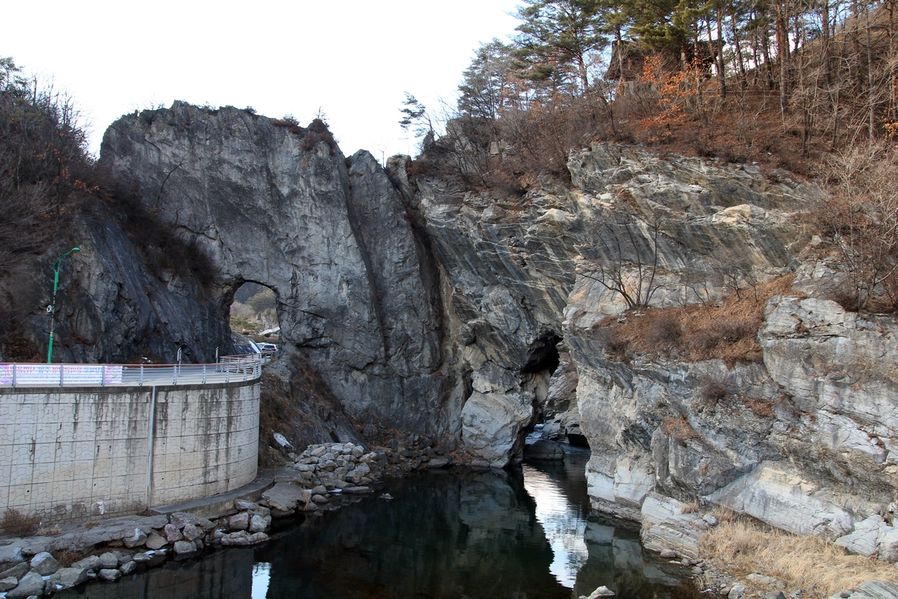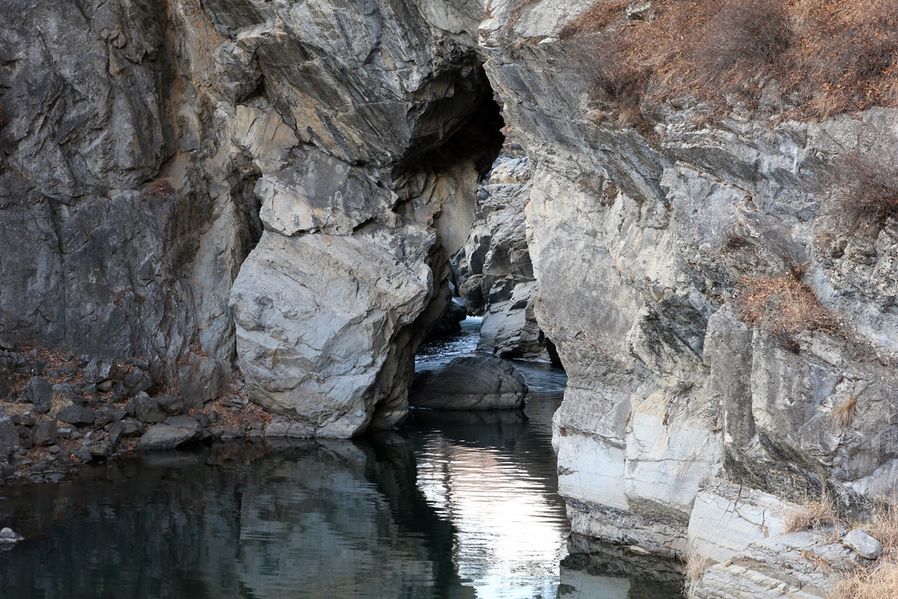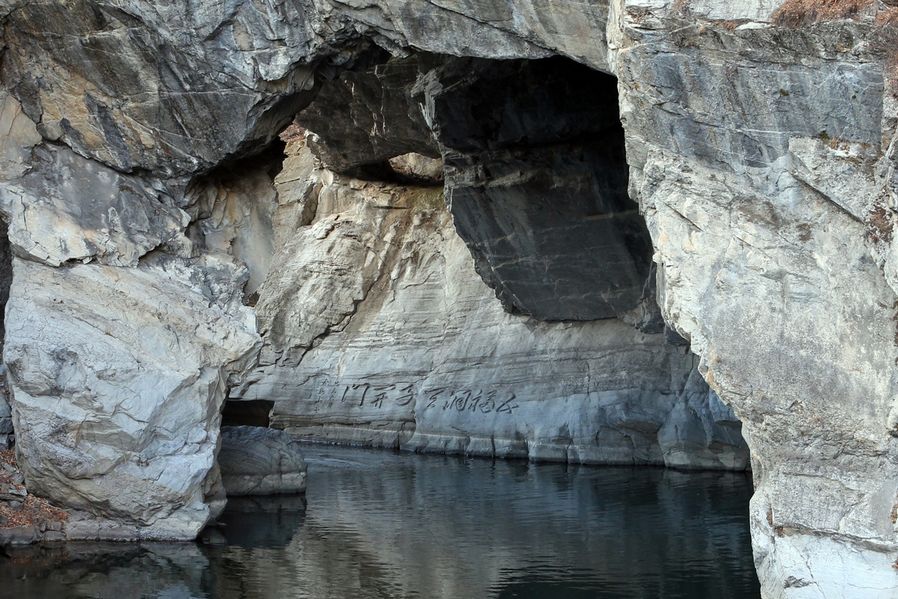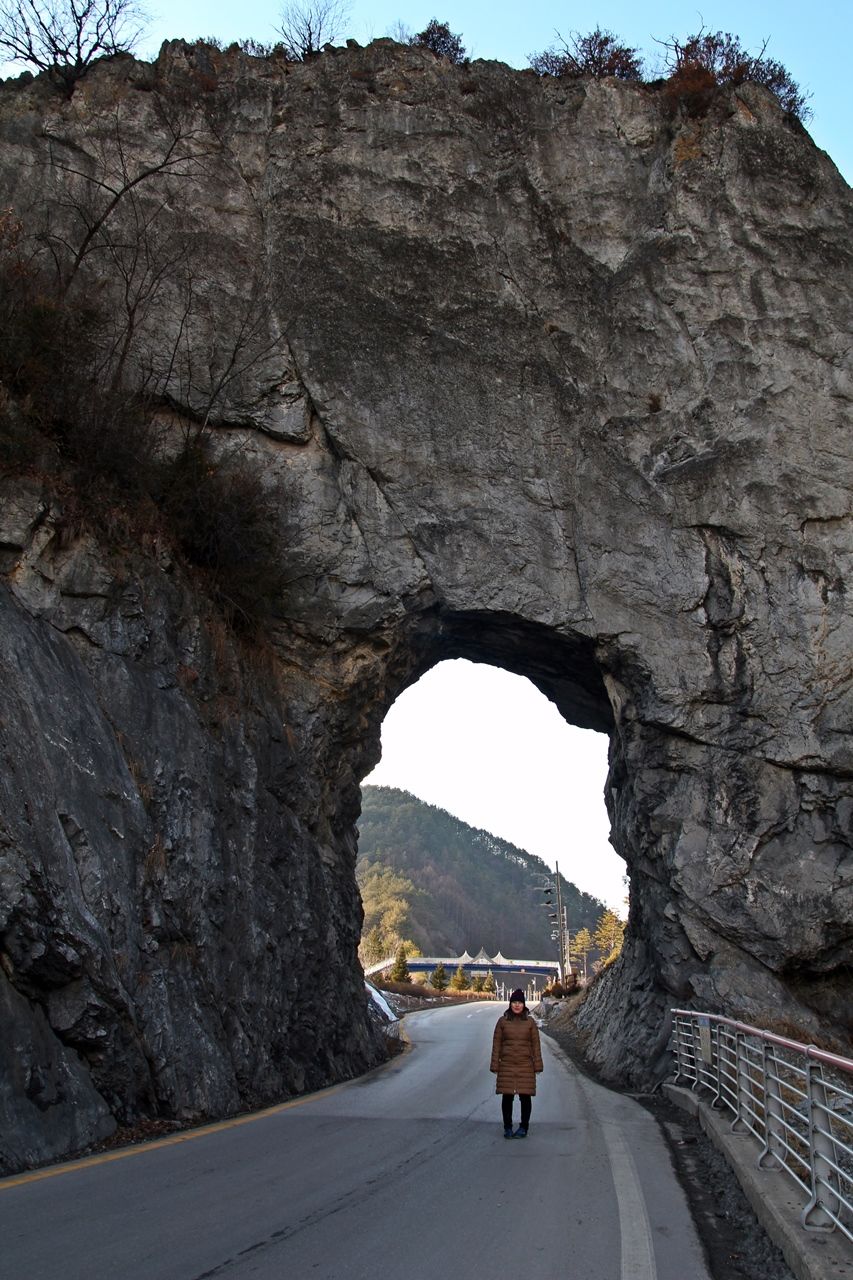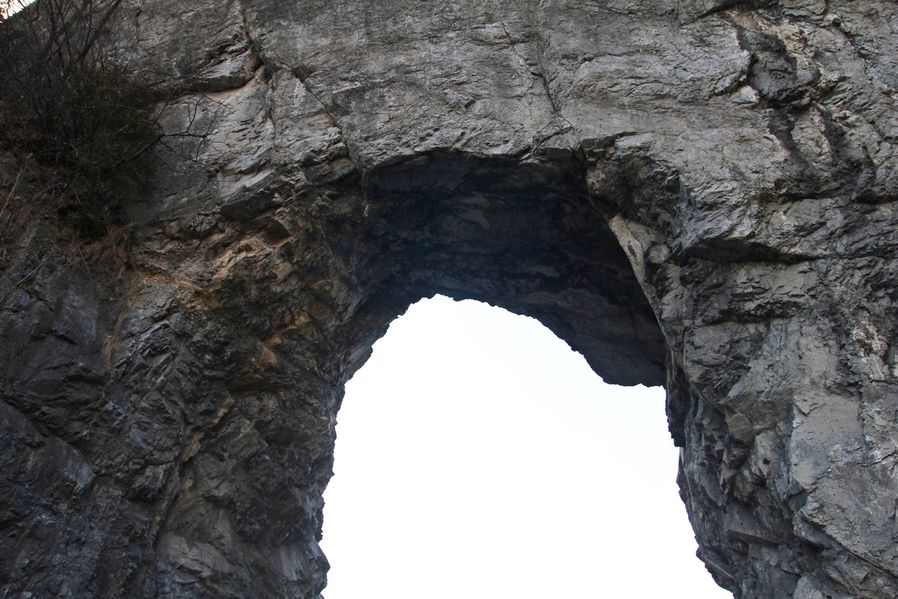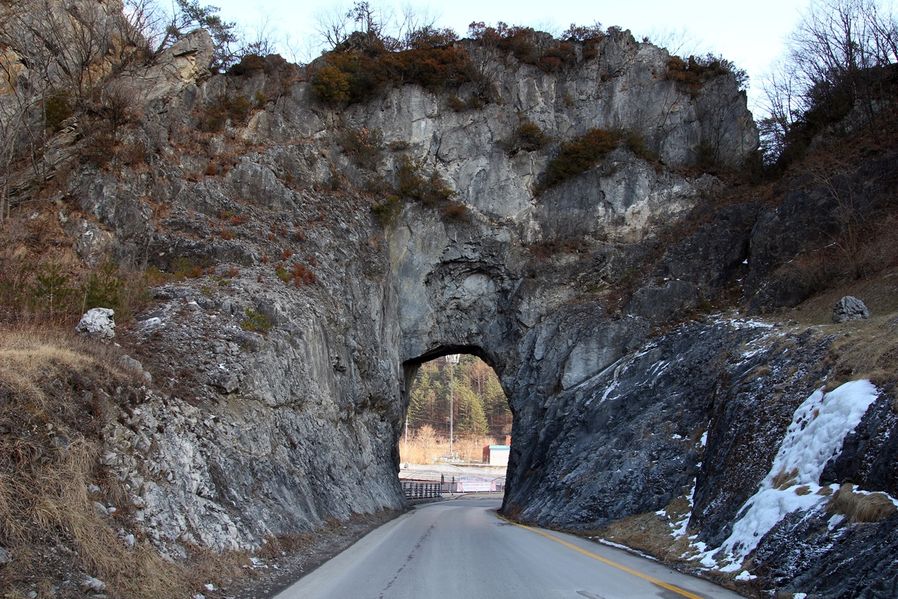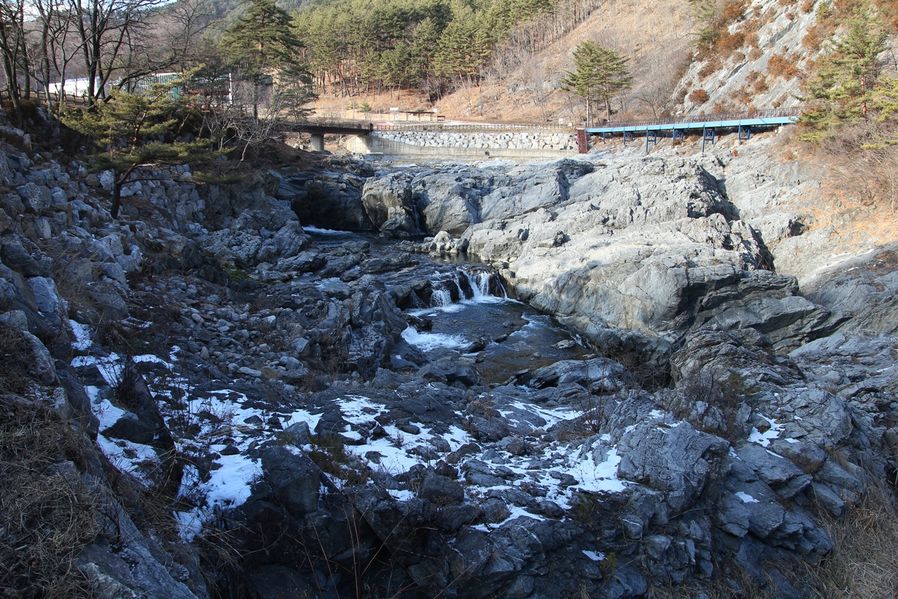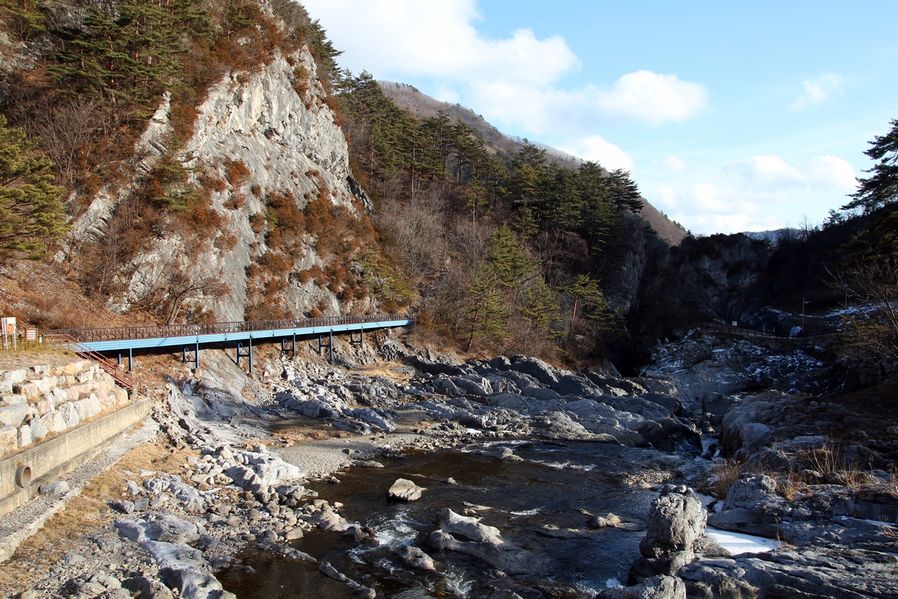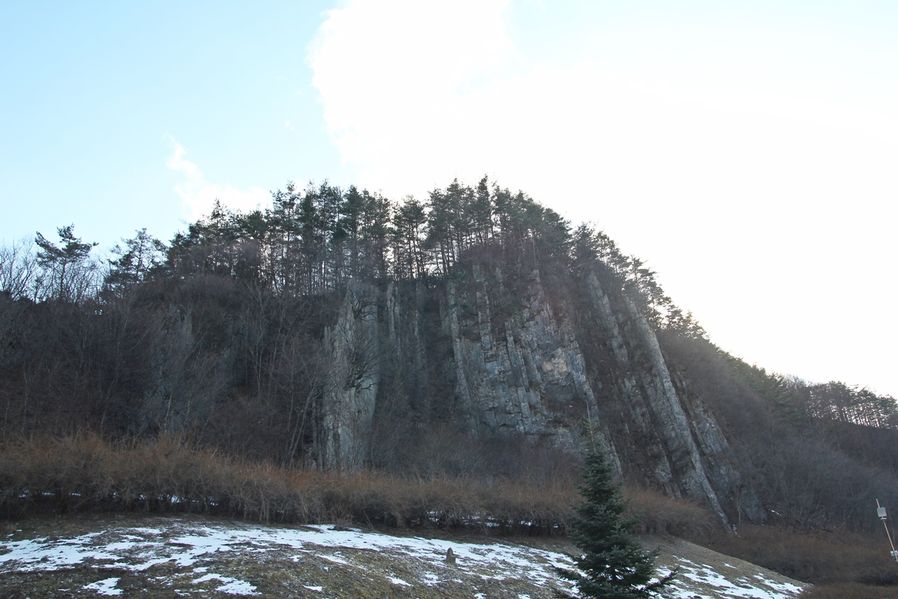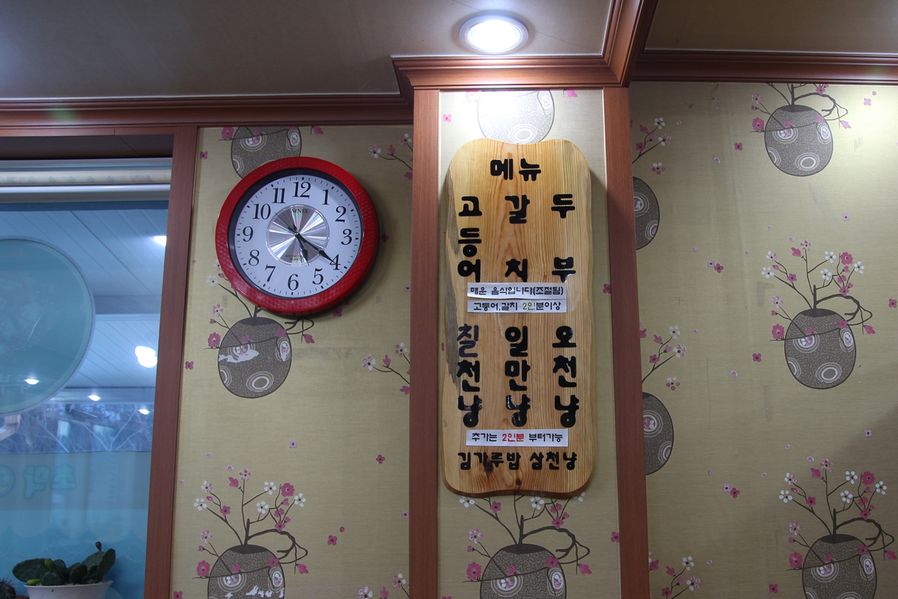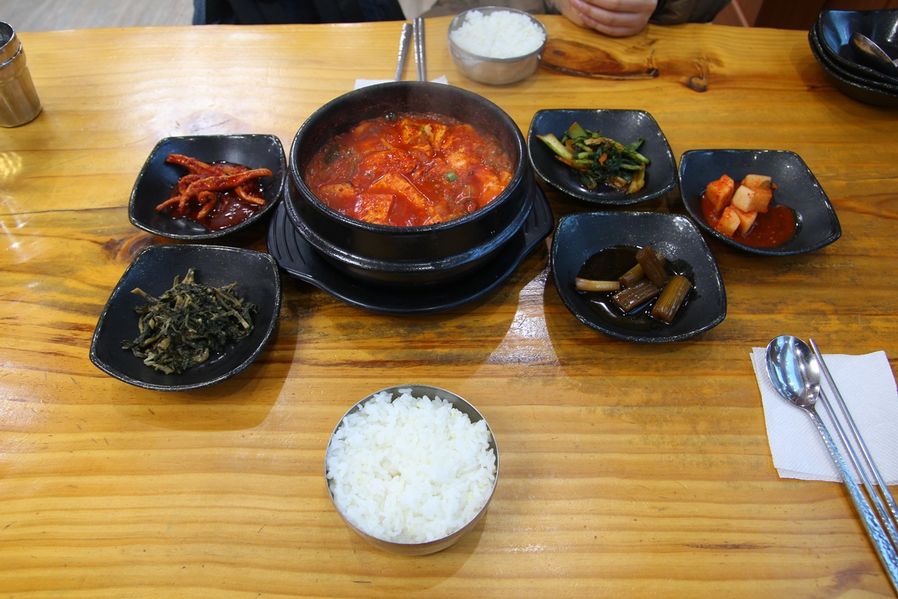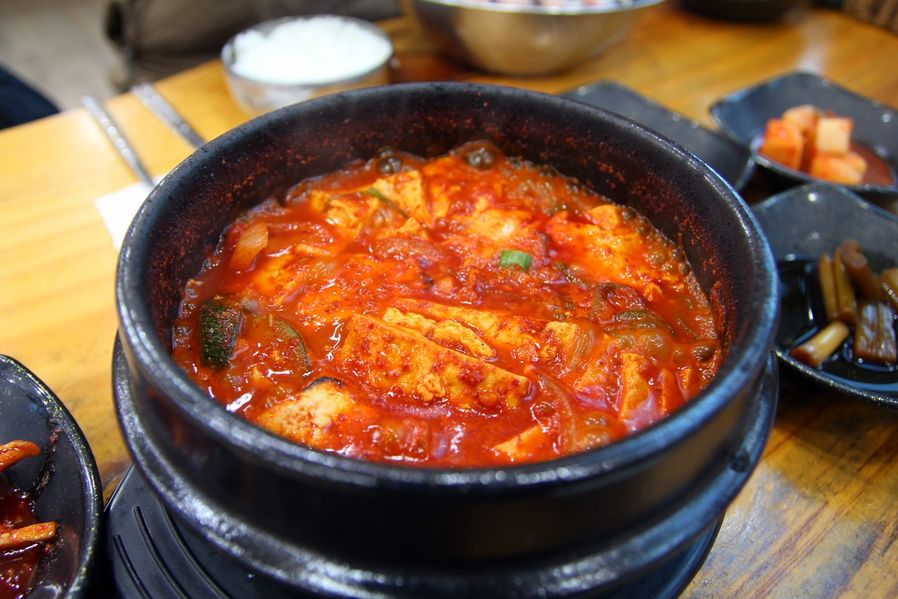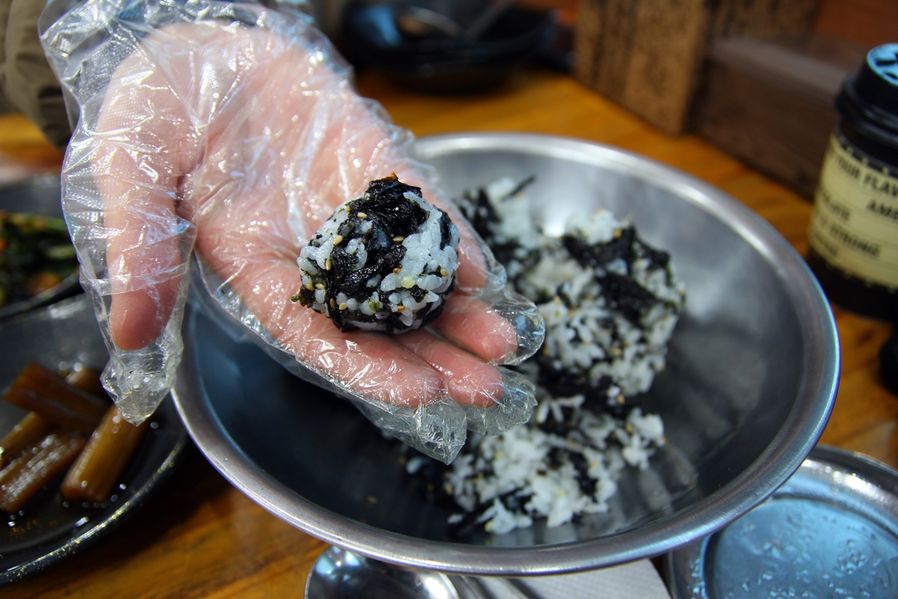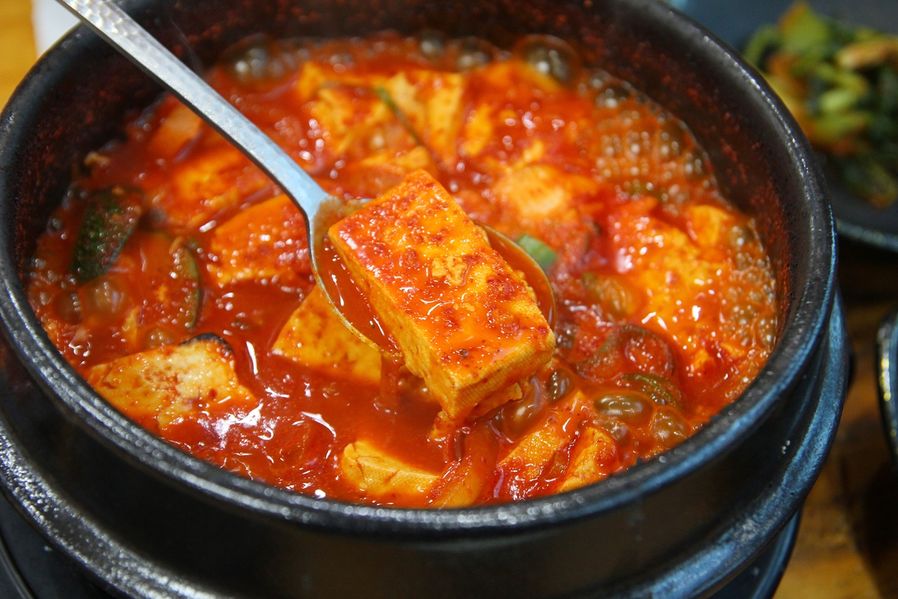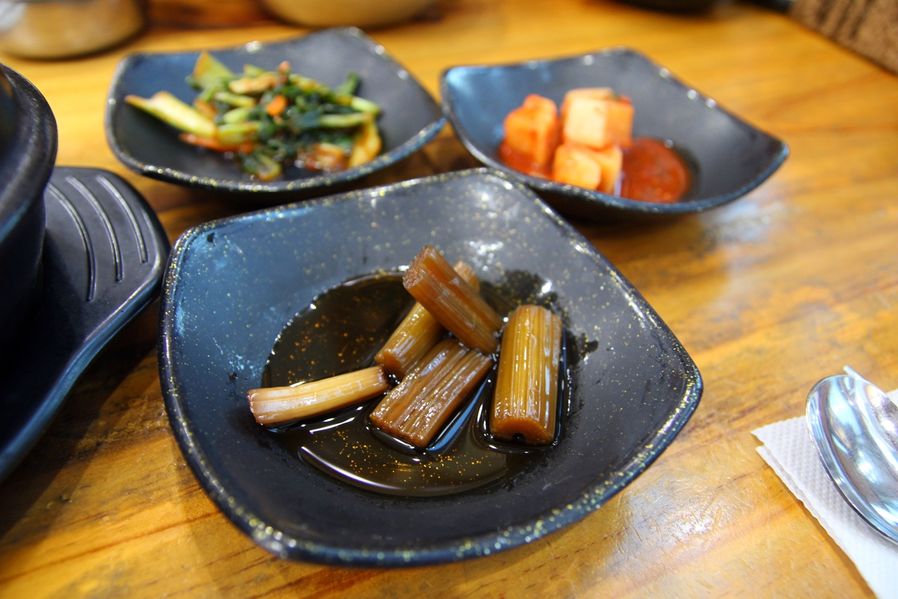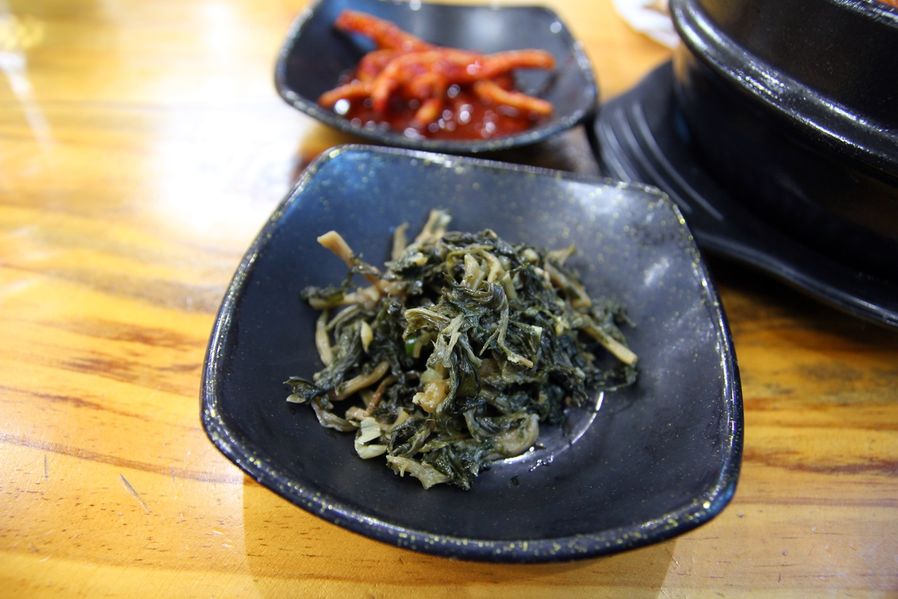-
Start
-
Snow Festival
-
Coal Museum
-
Hill of Wind
-
Yongyeon Cave
-
Chujeon Station
-
Hwangji Pond
-
V-Train
-
Buncheon Station
-
Coal Mine History Town
-
Paleozoic Museum
-
Gumunso
-
Finish
The Only River Flowing Through the Mountain! Gumunso in Taebaek
There is only one place that river flows through mountain in Korea. It's called Gumunso(求門沼) located in Taebaek-si, and Hwangjicheon, head of Nakdong River, made a hole in a rock by hitting it for a long time. Stagnated water finally dug a hole forming a stone gate(石門) and flowing water formed a pond(沼) so it's called Gumeongso(hole pond) or Gumunso. This area is natural monument No. 417.
Local people call this Tturunae because it flows into the mountain, and its view with pine trees grown above the rock looked amazing. Gumunso is 20-30m high and the pavilion over the stone gate is called Jagaeru, where the poets and artists used to visit often. This unique structure that the river crosses the mountain is called Dogangsanmaek(渡江山脈) formed 1,500-3,000 million years ago and this is the only place in Korea.
The streams here are all branches of Nakdong River but before the hole was made, Cheoramcheon (Cheoram River) used to flow here in the picture and Hwangjicheon(Hwangji River) was the opposite side. There's a legend about this. Before Gumunso was formed, white dragon and blue dragon fought over Nakdong-gang on the top of the castle wall but it was a nip and tuck so white dragon used a trick by drilling a hole in the rock and won. The correct story would be that it's water that made it all for an unimaginably long time but somehow I am attracted to white-blue dragons story.
There are Chinese letters (漢字) written by someone in the hole. It says 'Obokdongcheon Jagaemun(五福洞天 子開門)'. According to Jeonggamrok written in Joseon Dynasty, 'a stone gate shows up at the end of the head of Nakdong River, and when you cross it, the ideal world will show up.' Jagaemun(子開門) means the gate opens at the first of the 12 periods of the day(子時, 23:00 - 01:11), so it means if I pass this gate open at that time, I could go to paradise(Taebaek) where there are five blessings.
Right next to Gumunso, there's tunnel into a big rock for cars. I'll show you the picture just to show you the size of the rock. This hole was dug by Japanese in 1937 to steal coals. There's no way Japanese would leave Taebaek, repository of resources, in Japanese colonial era. Anyways, if you take a closer look at upper part of the cave, it says 'Uhyeolmogi(禹穴牟奇)' in Chinese. It means 'this cave strangely resembles the cave dug by the commands of Chinese King Wu' and it's written by Japanese to pretend they dug the hole for local people in Taebaek when they actually dug it for stealing resources.
I'm sure they forced local people to dig this tunnel. The holes in Korea including Jeju Island were made by Korean farmers and they were not even fed well. This has nothing to do with Taebaek tour but I'm just saying.
It's a big cool hole but right next to it, a new tunnel called Dongjeom Tunnel was built so not many cars pass through this hole.
Inside the tunnel, you'll see Hwangjicheon(River) and this is the starting point of 4km long trail along the valley. The reason why this was designated as a natural monument is because the fossils found here tell us that this used to be ocean. Right over there, you can see Paleozoic Museum, which was built for the same reason. Those who are interested in earth science would find this place useful just like a classroom. This place formed 300-500 million years ago is made of limestones produced in sea environment and it still keeps fossils of trilobites and various sedimentary stratums. I say this is the best place to study geographical science in Korea.
Plus, the pavilion I told you about, called Jagaeru over Gumunso, is right up there to the left.
This place used to be ocean a few hundreds of million years but now they have risen and became mountains. Where you set your eyes on, you'll be surprised to see unique rocks and stones and sedimentary stratums. That rock is a small mountain next to Dongjeom Tunnel, and it looks so amazing there even if it sounds foggy in the picture due to backlight. You should drop by while you drive in Taebaek.
+ Address : 6-3, San, Dongjeom-dong, Taebaek-si, Gangwon-do
'Chomakgogaldu' with Delicious Dubu-jorim(Braised Tofu) in Taebaek
Taebaek is surrounded by mountains so it's hard to find nice restaurants. As soon as you get out of downtown, you'd have to follow winding roads up and down the hills because it's underdeveloped and quiet city yet. Plus in winter, it has heavy snow and cold wave repeatedly so it's hard to stay away from flatland.
Nevertheless, at the end of Hwangji-dong far away from downtown, and even worse, on the mountainside, you will find a restaurant called Chomakgogaldu. It specialises in Jorim(food boiled down in soy sauce or other seasonings) cuisines, and it's always crowded with customers even if they have to drive all the way up on a snowy day just to eat here. As I was in Taebaek, I couldn't help but try it. Next day after heavy snow, I drove my car up to the mountain to have my last meal in Taebaek.
If you follow the road 10km further from Chomakgogaldu, you will see Maebong Windfarm(Hill of Wind), which is well-known for amazing view over cabbage patches and enormous windmills of wind plant. It's close to the restaurant so you could drop by before you eat, I suggest!
By the way, Chomakgogaldu is a quite unique name, isn't it? It's named by combining first letter of Godeungeo(mackerel), Galchi(hairtail) and Dubu(tofu). This restaurant specialises in cooking spicy Jorim which has mackerel, hairtail and tofu in an earthen pot, and I was there to eat braised fish but I was too exhausted to go all the trouble de-boning the fish so I had to order easy-to-eat Dubu-jorim(braised tofu) for 2. Plus, I ordered 'Gimgaru bap(rice with chopped seaweeds).
This is braised tofu seasoned in spicy sauce in an earthen pot served with 5 different common dishes. It seems quite simple probably because it's not so expensive. Well, people go through so much to eat this so I was excited a bit.
A few vegetables that add more flavours like onions, pumpkins, welsh onions, and chilli peppers along with tofu were braised in seemingly very spicy sauce.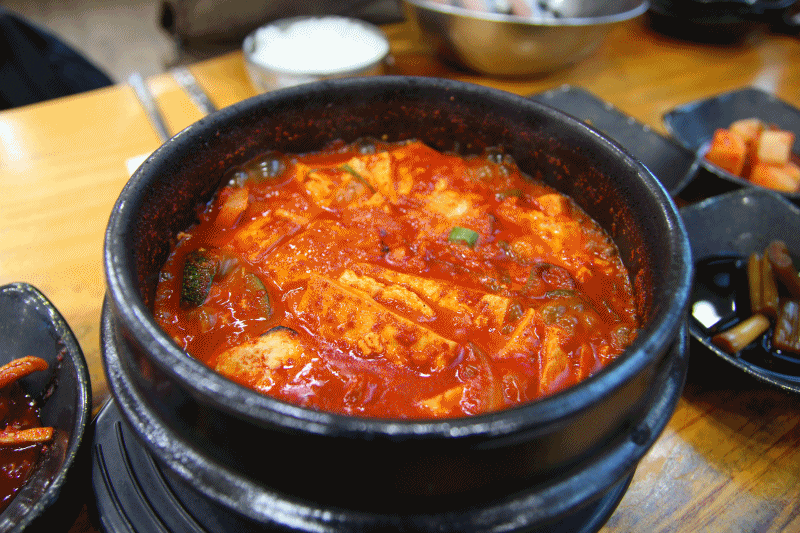
To see them boiling makes it look real, right? Taebaek is much colder than other cities and I thought this hot spicy food would warm my body. It looks really yummy, boiling in an earthen pot.
The Gimgaru bap that I added was served in a big bowl with a few drops of sesame oil on it and you can wear the plastic gloves served with it to mix it and make rice balls. Dubu-jorim is very spicy so I had to eat flavory Gimgaru bap to calm my mouth.
It's just tofu with a few vegetables braised in spicy and a little salty sauce but this simple cuisine made me finish one bowl of rice in an instant. I was kinda disappointed to see this simple table but I could finish one bowl of rice so easy with one pot of Dubu-jorim and there's no need for fancy dishes or meat. Well, I must say it's worth to go all the troubles to eat this. Even when I'm writing this post, I miss this bland and soft tofu braised in strong sauce although it tastes a little bit of artificial seasoning.
While I was so into Dubu-jorim my wife asked for more of pickled celeri twice. Pickled vegetables normally made of chilli peppers, cucumbers or white radish, so it was our first time to eat celeri but its unique flavour and crispness goes well with sour and salty sauce. Pickled celeri is so popular that you can buy them in the restaurant so you should try.
The common dishes were properly salty in general and delicious. Among them, pickled celeri was the best and next best thing was this stir-fried radish greens. Radish greens were boiled until they get soft and seasoned to keep its unique flavour and scent.
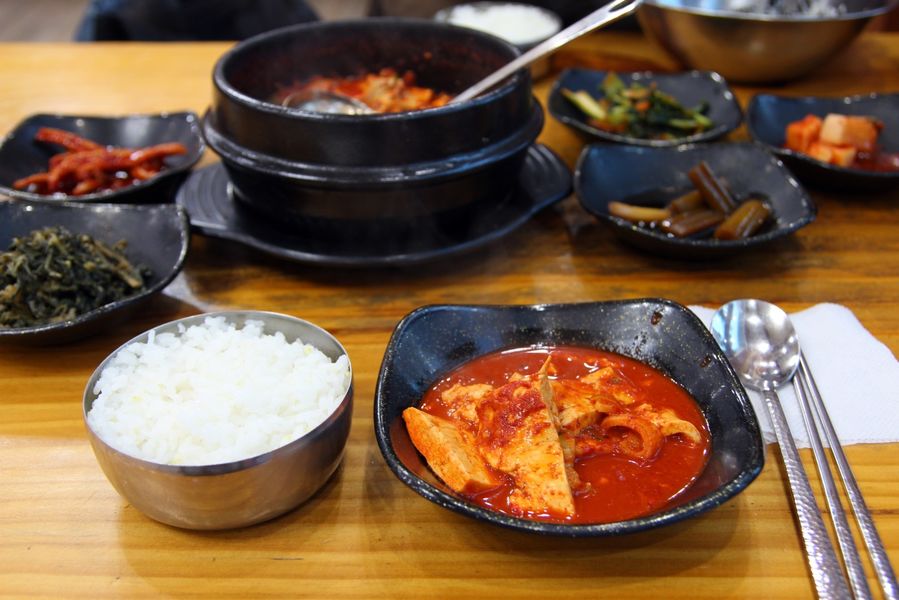
When we visited Chomakgogaldu, it was during the week but it was after the heavy snow and cold waves so it was hard for us to drive up. But when you get inside the restaurant located on the hillside, you'll find it crowded with customers. It means that its taste is recognised by tourists as well as local people. Indeed, I think the key to its success is artificial seasoning but even so, I could enjoy simple meal at a reasonable price.
+ Address : 317, Hwangji-dong, Taebaek-si, Gangwon-do
+ Telephone : 033-553-7388
+ Operating Hours and Holidays : 10:30 - 20:00, Closed on National Holidays











